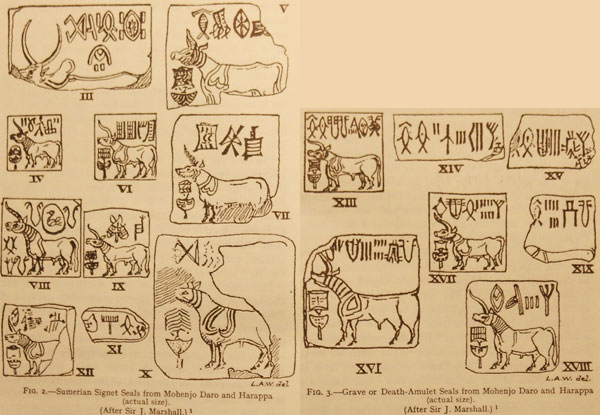|
 Indus Valley Civilisation:
(Pakistan)
Indus Valley Civilisation:
(Pakistan)
From about 2,600
B.C. to 1,700 B.C. a vast number of settlements were built along the
banks of the Indus River and surrounding areas. These settlements
cover a remarkable region, almost 1.25 million kilometres of land
which is today part of Afghanistan, Pakistan and north-western
India.
The Indus Valley
region was home to one of the great ancient civilisations, which was
on par with the Sumerians and Egyptians and at the same time. It
ended suddenly as did the Sumerians. It was not discovered until the
1920's. Most of its ruins, even its major cities, remain to be
excavated.
Article:
Nov, 2012 (GlobalPost.com):
'Archaeologists
Confirm Indian Civillisation is 2000 Years Older than Previously
suspected'
'Indian
archaeologists now believe the ancient Indian civilisation at
Harrapa dates back as far as 7,500 BC. �When Bhirrana
[Rajasthan] was excavated, from 2003 to 2006, Recovered
artefacts provided 19 radiometric dates,� said Dikshit, who was
until recently joint director general of the Archaeological
Society of India. �Out of these 19 dates, six dates are from the
early levels, and the time bracket is forming from 7500 BC to
6200 BC.�
(Link
to Full Article)
Indus Valley
Cities: Quick Links.
Harrapa: Northern
Indus Valley City.
Mohenjo Daro: Central
Indus Valley City
There are
several other cities now being discovered such as Dholavira,
Lothal, Ganweriwala and Rakhigarhi and many others expected in
the coming years. The underwater city discovered in the Gulf of
Cambay is suspected of being a part of the ancient Indus Valley
Culture.
The cities of
the Indus Valley Civilization were well-organised and built out of brick and stone. Their drainage systems, wells and
water storage systems were the most sophisticated in the ancient
world. They also developed systems of weights and trade. They
made jewellery and game pieces and toys for their children.
(Map of
the Indus Valley)
|
Mohenjo Daro:
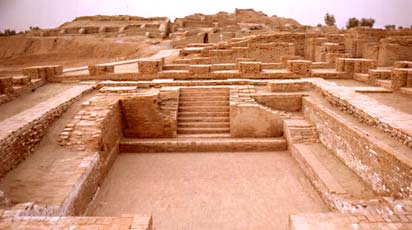
By far the
best known Indus Valley City. Mohenjo Daro remains
incompletely surveyed but has already revealed much
about the skills of the Indus Valley builders, craftsmen and
trade routes with other civilisations of the time such as
the Egyptians and Sumerians.
The Great
Bath at Mohenjo Daro is suggestive of a common or ritual
bath, other relics lend to the idea of a peaceful people who
appear to have come to a sudden and dramatic end.
(More
about Mohenjo Daro) |
|
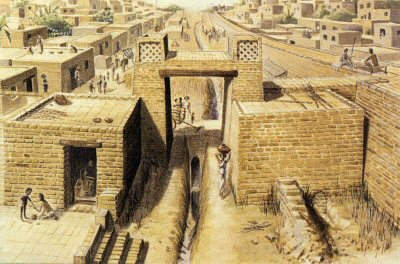 Harrapa: Harrapa:
The City of
Harrapa is recognised as a Northern equivalent of Mohenjo
Daro. Discoveries confirm that the same system of weights
and measures were used over a thousand kilometres apart.
Harrapa shows a continued habitation since 3,300 BC, through
which archaeologists have been able to better understand the
rise and fall of this great civilisation.
(More
about Harrapa) |
Well over a
thousand settlements are now known from the Indus valley
civilisation. The civilisation is known to have had a unity of
culture, art, script, and technology (even weights and measures).
The largest city, Mohenjo Daro is thought to have reached a
population of approximately 30,000, suggesting a total population of
approximately 5 million people. (1)
Chronology:
The Early Harappan
Ravi Phase, named after the nearby Ravi River, lasted from circa
3,300 BC until 2,800 BC. It is related to the Hakra Phase, identified
in the Ghaggar-Hakra River Valley to the west, and predates the Kot
Diji Phase (2,800-2,600 BC, Harappan 2), named after a site in
northern Sindh, Pakistan, near Mohenjo Daro.
The people of the Indus Valley Civilization also developed a
writing system which was used for several hundred years.
However, we are still unable to read the words that they wrote.
The earliest examples of the Indus
script date from around 3000 BC (2)
The seals above illustrate how similar animal figures were repeated,
while the script varies.
Well over 400 distinct Indus symbols
(some say 600)
(3) have been found
on seals, small tablets, or ceramic pots and over a
dozen other materials, including a "signboard" that
apparently once hung over the gate of the inner citadel
of the Indus city of Dholavira. Typical Indus
inscriptions are no more than four or five characters in
length, most of which (aside from the Dholavira
"signboard") are exquisitely tiny; the longest on a
single surface, which is less than 1 inch (2.54 cm)
square, is 17 signs long; the longest on any object
(found on three different faces of a mass-produced
object) has a length of 26 symbols.
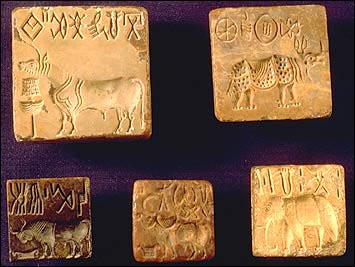
Each seal has both an image
and several characters.
|
Article: Computers unlock secrets of
Indus-Valley script. (Science Daily: 2009)
A team led by a University of
Washington researcher has used computers to extract patterns in
ancient Indus symbols. The study, published this week in the
Proceedings of the National Academy of Sciences, shows distinct
patterns in the symbols' placement in sequences and creates a
statistical model for the unknown language.
Despite dozens of attempts,
nobody has yet deciphered the Indus script. The symbols are
found on tiny seals, tablets and amulets, left by people
inhabiting the Indus Valley from about 2600 to 1900 B.C. Each
artefact is inscribed with a sequence that is typically five to
six symbols long.
Some people have questioned
whether the symbols represent a language at all, or are merely
pictograms of political or religious icons.
The new study looks for
mathematical patterns in the sequence of symbols. Calculations
show that the order of symbols is meaningful; taking one symbol
from a sequence found on an artefact and changing its position
produces a new sequence that has a much lower probability of
belonging to the hypothetical language. The authors said the
presence of such distinct rules for sequencing symbols provides
further support for the group's previous findings, reported
earlier this year in the journal Science, that the unknown
script might represent a language.
"These results give us
confidence that there is a clear underlying logic in Indus
writing," Vahia said.
Seals with sequences of Indus
symbols have been found as far away as West Asia, in the region
historically known as Mesopotamia and site of modern-day Iraq.
The statistical results showed that the West-Asian sequences are
ordered differently from sequences on artefacts found in the
Indus valley. This supports earlier theories that the script may
have been used by Indus traders in West Asia to represent
different information compared to the Indus region.
(Full Article) |
Link with Easter Island script (Rongo-Rongo)
It has been observed that
Easter island is diametrically opposite the Indus-Valley city of Mohenjo-Dharo
and that the Indus
valley script shares many similar symbols to Easter Island's 'Rongo-Rongo'.
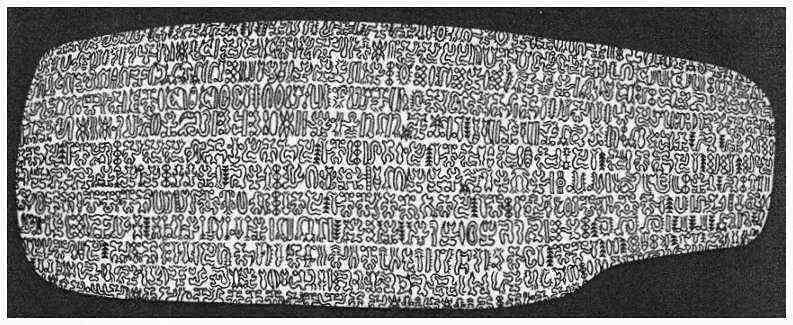
(Comparison of Easter Island and Indus Valley
Scripts)
(More about Easter Island)
|
Connections with other Ancient Civilisations: |
The Gilgamesh Connection.
It was long suspected that there was a connection between the early
dynastic Egyptians and the Sumerians. The Knife found at the Royal cemetery in
Abydoss (right), with its depiction of Gilgamesh, is proof enough, but the
following information suggests that this prehistoric cultural link may have been
stronger than once thought.
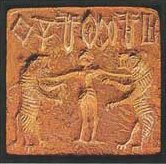
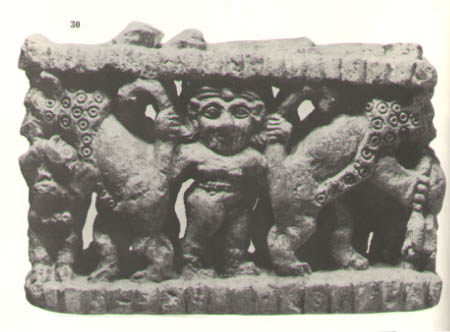
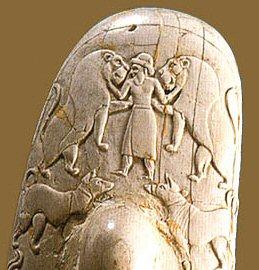
Gilgamesh in
Mohenjo Daro, Indus Valley (left),
Sumeria (centre) and Abydoss, Egypt
(right).
The 'Gilgamesh' figure is an iconic Sumerian
image, found in other prehistoric civilisations such as Early Dynastic
Egypt and the Indus Valley. Curiously enough, the same figure, but with
a woman between the felines is found at other prehistoric
locations such as the Mycenaean, Anatolian and Maltese.
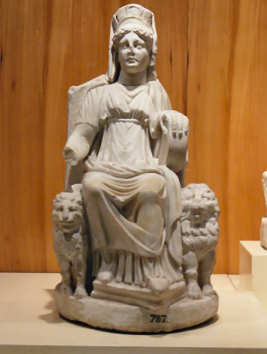
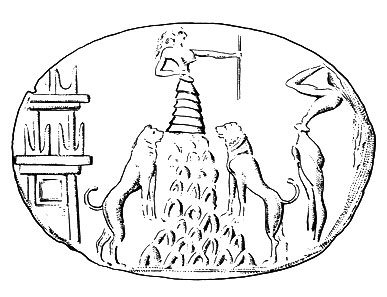
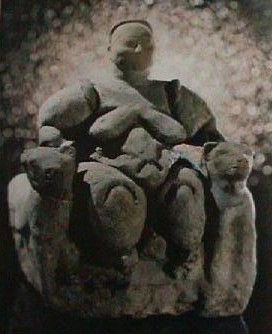
If we go back further into Anatolian prehistory to
Catal hoyuk (8,000 B.C.), for example, we can
also compare the figurine of a large female sitting upon a throne flanked by
either Lions or leopards (right). The Prehistoric European Earth Goddess or Cybele
(left), is also often depicted enthroned with lions as was the
Minoan mountain goddess (centre).
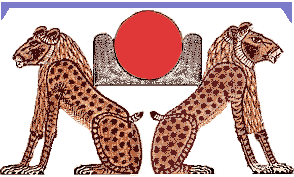
It is perhaps interesting to note, in relation to the prehistoric images of
an Earth-Mother-Goddess with Lions on either side, that the Egyptians used the
symbol of two lions 'Aker' to represent the horizon. In this context, we can see
through these earlier iconic images of a female Earth-Mother-Goddess flanked by
felines, a depiction of the literal Earth itself.
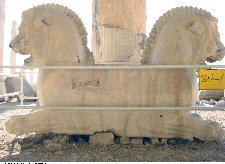
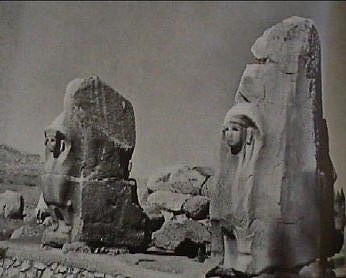
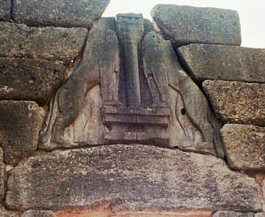
The same symbols were later used as 'guardians' of important cities, temples
etc.
(From left to right - Persepolis, Alaya Huyuk,
Mycenae)
The Sumerian Seals:
International Trade.
Archaeologists can use both the trade in seals themselves,
as well as the distances between seals and the corresponding sealings, to trace long-distance trade networks. One such
set of seals were manufactured around 1,900 B.C. on two
important island trading cities in the Persian Gulf - Bahrein and Failaka. These seals were traded all over the
Middle East, and have been found at diverse and distant
locations such as Susa in Iran, Bactria in Afghanistan, Ur
in Iraq, and Lothal on the west coast of India. By 1,750
B.C. Common Style seals are found in locations ranging from
Spain, to Mycenaean Greece, to Marlik near the shores of the
Caspian Sea. These seals were made from faience, a less
expensive material, and used by smaller merchants.
(4)
(Harrapa)
(Mohenjo Daro)
(The
Sumerians)
(Prehistoric
India)
(Indus
Valley - Easter island Script)
|

 Harrapa:
Harrapa:
